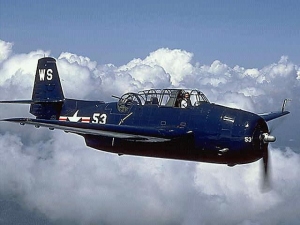|

|
First flown on August 1 1941, the three-seat Grumman TBF-1 Avenger torpedo-bomber entered US Navy service just in time to participate in the Battle of Midway in June 1942. During its World War II lifespan, the Avenger design changed very little, and this allowed it to be built in huge quantities. Demand for the airplane was so great that the General Motors Company was also contracted to build it, under the designation TBM-1, beginning in September 1942. Over 1,000 TBF/TBMs (initially called Tarpon Mk I, and later designated Avenger Mk I) were also used by the Royal Navy's Fleet Air Arm in both Atlantic and Pacific theaters. The Avenger was also used by the Royal New Zealand Air Force. The second major variant was the TBM-3, which featured strengthened wings to allow rockets and radar pods to be carried. A large percentage of the TBM-3s were delivered with their large dorsal turrets removed. The Avenger's torpedo-delivery capability had a huge impact on the Japanese fleet during the war, and its rugged simplicity made it highly resistant to enemy air defenses. A total of 2 289 aircraft were completed by March 1945 and included variants such as the baseline TBF-1, TBF-1B (402 aircraft) delivered to the UK, TBF-1C (764 aircraft) with two 0.5in machine guns in the leading edges of the wing, and the TBF-1D for the anti-submarine role with radar and underwing rockets.
|